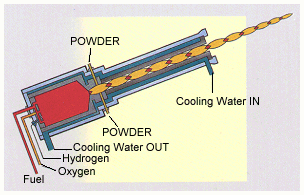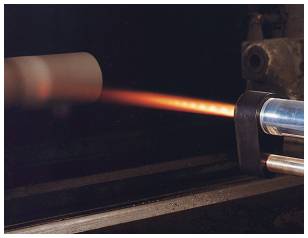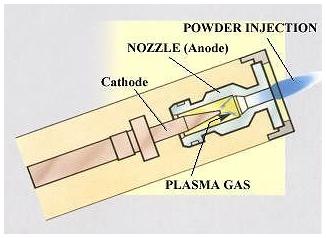Unsteady Heat Transfer |
||
Unsteady Heat Transfer Analysis Lumped Capacitance Method (LCM) Basic Thermal Spray Processes Thermal Spray Equipment Industrial Applications Some Other Thermal/Chemical Deposition Technology |
Many real-world thermal problems requires the understanding of the transient time response of the heat transfer process. The unsteady behavior of such a system can be analyzed by using the unsteady heat equation and applying the proper initial and boundary conditions. One such example is the thermal spray process commonly used in material coating industry. Fine solid particles are injected into a stream of high temperature gas flow. The particles are soften or melt before they strike onto the processed surface, providing a layer of uniform coating for protection, wear-resistance or as thermal barrier. The complete process is very complicated involving high temperature physics, fluid mechanics, material characterization, and unsteady heat transfer. The following is a short introduction of two typical thermal spray processes (HVOF and Plasma Spray).
Thermal Spray Process HVOF High Velocity Oxygen Fuel (HVOF) process involves the use of exhausted flame gas from a combustor to accelerate the injected coating particles to very high velocity (can be exceeding 1500 m/s well into the supersonic range). The high energy impact of the high velocity particles will be enough to coat the material onto the surface and the completely melting (phase transition) of the particles is not required. Therefore, it usually can provide a thicker and more uniform coating compared to other thermal spray process. As ahown in the following figure, periodic shock structures (usually be called as shock-cells) exist inside the high speed jet, as also evident from the picture following the schematic.
HVOF System from Metal Spray Supply, Inc.
Plasma Spray The Plasma jet sprays molten or softened material onto a surface to provide either a protective coating or a thermal barrier. Material in the form of fine particles is injected into the plasma flame, where it is rapidly heated and accelerated to a high velocity. The hot material impacts on the substrate surface and rapidly cools to form a coating.
Plasma Jet from Metal Spray Supply, Inc.
|
|

 Coating Process
Coating Process
